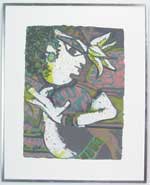From the collection of:
Jacobs Collection at Georgetown College || VAM Home
Robert Kushner (American, b. 1949)
BALLAD TRISTE, 1980
Mixed-media intaglio on handmade paper; 34" X 42"
Collection of Dr. and Mrs. Donald Jacobs
While Ballad Triste has a contemporary flair, it is rendered in the style of an ancient Egyptian artwork. For instance, the figure’s dark hair, darkly lined eyes, and decorative garb are evocative of an ancient Egyptian subject. And while the figure is depicted in profile, his or her eye appears in full view, staring head-on at the viewer, and the artist has made no attempt at naturalism in the positioning of the body. The shapes in the background appear almost like modernized hieroglyphics. On the other hand, the acidity of the palette—from fuchsia to chartreuse to turquoise—breaks from the earthy colors of antiquity and creates a contemporary appearance.
About the Artist
Born in 1949 in Pasadena, California, Robert Kushner received his B.A. from the University of California at San Diego in 1971 and moved to New York the following year. Both a painter and a sculptor, Kushner first gained public recognition as a performance artist in the 1970s. He is considered one of the founders of the Pattern and Decoration (or “P and D”) movement, which developed in the 1970s as a reaction against the stigma associated with the decorative arts in the contemporary art world. The Pattern and Decoration artists aimed to dissolve the boundaries between so-called “high art” and crafts.
In his own work, Kushner incorporates fabric into bold, large-scale renderings of the human figure. He began to collect 18th-century textiles more than 30 years ago and has used fabric in his work ever since. His travels to Central Asia inspired him to adopt the Asian technique of sewing together fragments of found and painted fabrics.
Since 1982, Kushner has collaborated with master printer Bud Shark on various monotypes and lithographs, producing prints that include collage-like elements such as glitter and metal leaf. His work has been exhibited nationally in several leading museums and galleries.
Classroom Ideas
Discussion: Describe Ballad Triste. Is the subject rendered proportionally? Does the stance of the figure give you any indication of the kind of activity in which he or she is involved? Why might the figure’s hand be cupped in such an unusual position? Does this work remind you of any works by other artists in the Kentucky Virtual Art Museum? Compare Ballad Triste to Pablo Picasso’s Woman in the Studio in the Speed Art Museum gallery.
Activity: Research the art of ancient Egypt, particularly the frontalism style. Try your hand at a portrait that incorporates the characteristics of frontalism but still has a distinctly modern look.
Links
Read brief profiles of Kushner and view examples of his work at the Hui No’Eau Visual Arts Center and the Contemporary Museum Honolulu.
[www.huinoeau.com/pro_KUSHNER.htm]
[www.tcmhi.org/ex_fhc1fall01.htm]
Learn more about frontalism and ancient Egyptian art and culture at the Academy for the Advancement of Science and Technology.
[www.bergen.org/AAST/Projects/Egypt/egyptian_art.html]
Explore The Art of Ancient Egypt at the Metropolitan Museum of Art.
[www.metmuseum.org/explore/newegypt/htm/a_index.htm]

